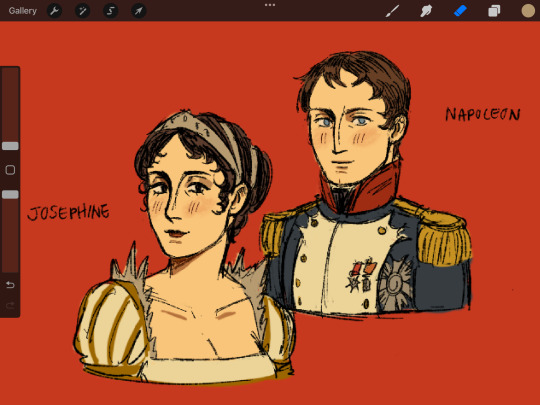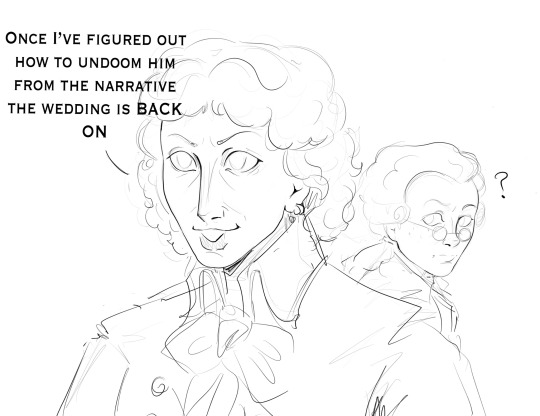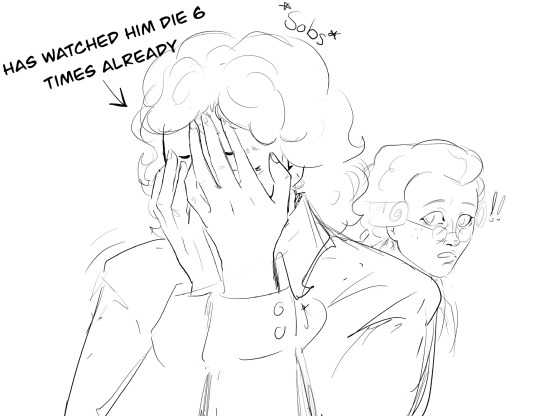#antoine de saint-just
Explore tagged Tumblr posts
Text
Some Julius Caesar x The Danton Case Parallels to Celebrate the Ides of March, Frev Style 🔪🥳
Firstly, both Przybyszewska’s Danton Case and Shakespeare’s Julius Caesar are obviously (excellent!) tragedies that are set in a dying republic on the brink of collapse.
Here are some other interesting parallels I was able to trace:
1. Brutus and Robespierre:
Both of them are driven to execute an important figure even though they initially do not want to do it. They are both conflicted but feel like they have no other choice and have to commit the violent act for the good of the republic.
They are also arguably quite alike in terms of character: you have the „noble Brutus“ and then Robespierre, who is consistently referred to as „the Incorruptible“. Both are seen by others as selfless and committed to the good of the state (the people in the crowd very much emphasise this fact in both of the plays, I do have the receipts)
There is even the scene in which Brutus chastises Cassius for taking bribes, which plays into the idea of him as being (literally) “incorruptible” as well. And vice versa, traces of Brutus’ famed stoicism can then certainly be found in Maximilien.
2. Cassius and Saint-Just:
Both are characters who convince the protagonists (Brutus/Robespierre) to go along the violent act while not necessarily being portrayed as antagonists (at least Saint-Just definitely can't be seen as one in Przybyszewska’s play).
There are also parallels in the close relationship between Brutus and Cassius and Robespierre and Saint-Just, where they are very much portrayed as each other’s closest confidants. Of course, this idea can easily be pushed even further if one wishes to read between the lines. (There is no Camille Desmoulins in Shakespeare though)
3. Manipulating the Crowd:
I'm perhaps the most fascinated by how both Brutus and Mark Antony as well as Robespierre and Danton have the necessary rhetorical skills to manipulate the crowd of commoners (Robespierre being able to “play the crowd like an organ” very much came to my mind when I was reading Act 3 Scene 2 of the Shakespeare’s play).
Both Shakespeare and Przybyszewska portray “the court of public opinion” and how it can easily be manipulated - how opinions can be changed in the matter of minutes - in a way that is genuinely fascinating.
Specifically, the similarity between A3S2 in which people first listen to Brutus only to be immediately swayed by Mark Antony’s speech shortly after and the scene in the court in which Danton manipulates the crowd were in fact so similar in some respects that it was borderline uncanny.
The problem arises when looking for a mirror to Danton’s character in Shakespeare’s play.
4. The Case for Danton x Caesar:
It is Caesar who gets killed for being perceived as a danger to the republic
Both Caesar and Danton are portrayed as being very much beloved by the common people
Also, the idea of Danton being immortal is expressed at the end of Przybyszewka’s play, and while he does not come back literally as a ghost like Ceasar does, Robespierre nonetheless explains to Saint-Just that Danton’s spirit never truly dies.
5. The Case for Danton x Mark Antony:
If we see Danton and Robespierre as foils, Mark Antony makes more sense as a parallel to Danton (even though he does not die), since both Robespierre and Brutus as the classic ascetic/stoic archetype while Danton and Mark Antony’s are well-known for their appetite for drinking, women (or, you know, people, in the case of Mark Antony) , and the pleasures of life overall.
Both are also severely underestimated by their enemies at first, yet they prove to be quite cunning and are able to use their words skilfully to win over the public
Overall, reading both of the plays – especially the parts about manipulating the Roman public and the citizens of Paris just with the power of words – really makes me wonder if Przybyszewska read Shakespeare’s play and used it as a source of inspiration. It would make sense, especially given how the parallel between the French Republic and the Roman Republic was well-established long before her time (even, somewhat tragically, by the revolutionaries themselves).
I promise I think about Przybyszewska's and Shakespeare’s play and the Roman Republic along with the French Revolution a totally normal amount of time & that it definitely does not consume my every waking thought that should be very much going towards the exam preparation.
#ides of march#julius caesar#brutus#french revolution#maximilien robespierre#the danton case#stanisława przybyszewska#william shakespeare#mark antony#literature#classic literature#english literature#literary analysis#(attempted)#marcus junius brutus#georges jacques danton#antoine de saint-just#saint just#robespierre#frev#frev community#history#renaissance#tagamemnon#classics#roman republic#ancient rome#classic studies#you can tell this was not AI generated by the fact that it is so chaotic and at times barely coherent#but there is heart in it okay
79 notes
·
View notes
Text
Happy Birthday Antoine de Saint-Just!

#history#european history#french history#french revolution#frev#antoine de saint just#antoine saint just#louis antoine de saint just#antoine de saint-just#antoine saint-just
13 notes
·
View notes
Text




Watched la Mort de Danton in theater this Friday and there were some fun arrangements :)))
1K notes
·
View notes
Text




The Triumvirate(s)?
Happy New Year!!!
Havent been very active here bc i was preparing my application for new school.
#myart#frev#fanart#maximilien robespierre#frev art#18 century#saint just#georges couthon#french revolution#frev community#frevblr#louis antoine de saint just#robespierre
360 notes
·
View notes
Text

Saint Just for my school art assignment
#based off of that one enjolras drawing#everything is highkey off but don't look at it too hard#also click on img for better quality pic#saint just#louis antoine de saint just#frev#frev art#french revolution#frevblr#louis xvi#art tag#frev community#history#18th century
717 notes
·
View notes
Text

who even are these people
#frev#french revolution#louis antoine de saint just#antoine saint just#saint just#maximillien robespierre#frev art#rip sj you would have loved tributing#art tag#quick colored sketch
190 notes
·
View notes
Text
Art dump! Sorry for the hiatus, but I’ve been pretty busy lately 😭. This is all random stuff from November/December btw.
Also, here's Saint-Just! I might make more frev art, but I want to read more about it, so probably in the distant future lol.





Also, happy new years everyone!! 🎉🎉
#napoleonic era#napoleonic wars#art#my art#joachim murat#jean lannes#jean baptiste bessières#jean baptiste bernadotte#napoleon bonaparte#louis antoine de saint just#frev#josephine de beauharnais#more lannes art but i've been reading his biography recently so it felt obligatory haha
301 notes
·
View notes
Text

Saint-Just and his hairstyles.
#french revolution#frev#frev art#frevblr#antoine saint just#saint just#louis antoine de saint just#shoddy explanation for SJ’s confusing ever changing hair in portraits#octavodecimo’s art
237 notes
·
View notes
Text


Who ordered a um… *checks receipt* a Frev timeloop au?
#saintspierre#antoine de saint just#antoine saint just#saint just#robespierre#maximilien robespierre#frev#frevblr#frev art#Saint-just is going through it ya’ll#Robespierre keeps dying no matter what he does#the timeloop resets everytime Robespierre dies#or if Saint-Just does#he’s never gotten further than thermidor 10
189 notes
·
View notes
Text

happy birthday antoine!
a yassified semi realistic sketch of my interpretation of him
289 notes
·
View notes
Text
Dear friends, today is my birthday, and I would be glad to see your reblogs of my arts and some kind words for me ❤️🔥










#history#french history#history art#napoleonic#napoleon#napoleon bonaparte#aglae ney#michel ney#aglae and michel ney#josephine beauharnais#napoleon and josephine#empress josephine#madame lamballe#princess de lamballe#robespierre#antoine saint just#artists on tumblr#digital art
269 notes
·
View notes
Text


Bonjour, Frevblr. I'm currently learning how to draw these guys... ^_^
Robespierre 🍊 and Saint-Just 🪽
#maximilien robespierre#louis antoine de saint just#frev#frev community#frev fanart#frev art#french revolution#robespierre#saint just#my art#fanart
288 notes
·
View notes
Text
Stupid hamsters



Throw all three of them into the oven
#frev#art#french revolution#lottie art tag#frev art#camille desmoulins#camille#desmoulins#maximilien robespierre#maximilien de robespierre#robespierre#louis antoine de saint just#saint just#antoine saint just
202 notes
·
View notes
Text



Random blorbos
#frev#louis antoine de saint just#baldwin iv of jerusalem#doodle to celebrate his 850th coronation this July :))#x men#cherik#charles xavier#erik lehnsherr
842 notes
·
View notes
Text

The duo, Robespierre and Saint-Just.
I recently went to the temporary exhibition at Musée Carnavalet in Paris about the height of the French Revolution. It inspired me to draw these two again hehe
#myart#digital art#french revolution#frev#frev art#frevblr#louis antoine de saint just#saint just#robespierre#maximilien robespierre
166 notes
·
View notes
Text

It ain’t mine unless it’s dumb.
#cartoon#my art#cachicabra#frev#french revolution#maximilien robespierre#louis antoine de saint just#camille desmoulins#speedpaint
184 notes
·
View notes